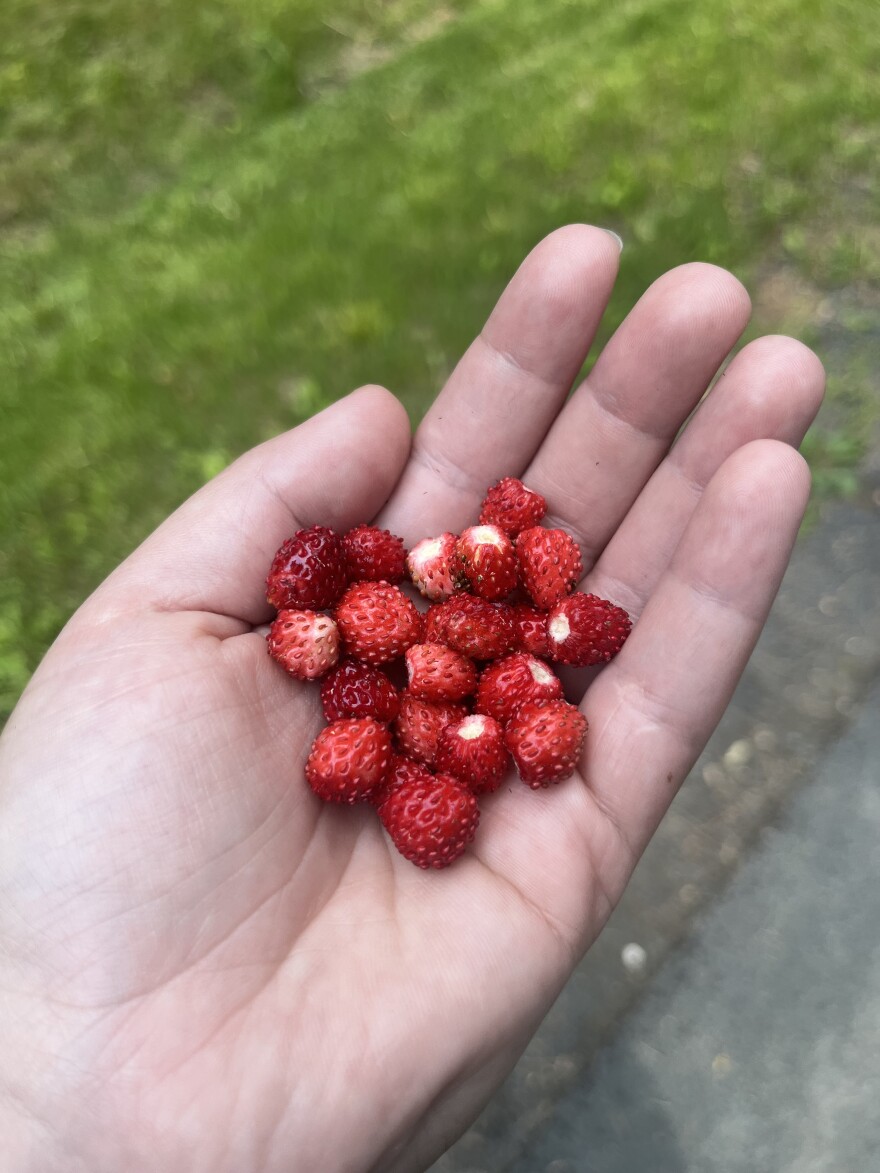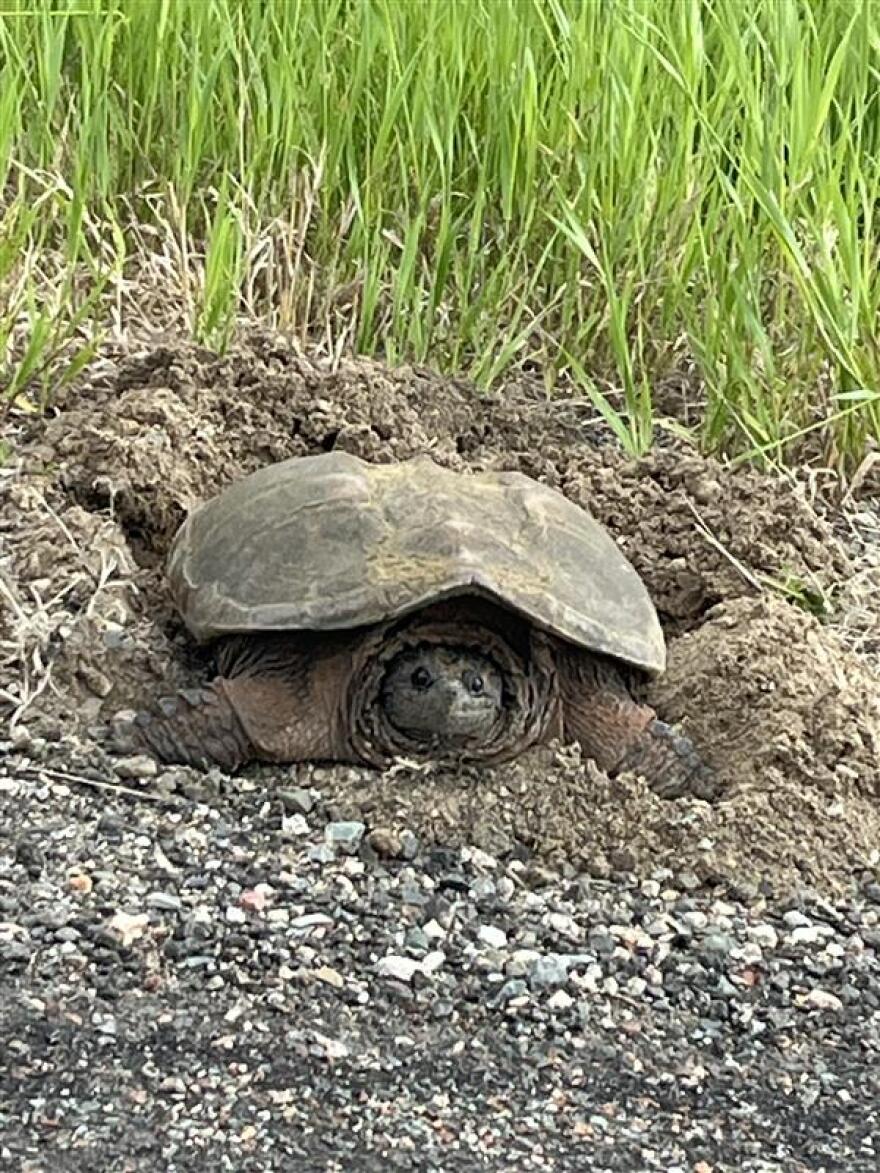Charlie Mitchell from Marine on St. Croix
"Good morning, John and Heidi! This is Charlie reporting from the Marine on St. Croix area.
“In last week’s Season Watch Newsletter, I wrote about a patch of wild strawberries growing along the road near my house. I’ve been scarfing down handfuls every time I pass by, and I’ve been passing by a lot more now that I know they’re there. Here’s part of what I wrote:
‘These aren't the strawberries you find at the store. They are wild, with an incredible concentration of sweetness, flavor, and nutrients stuffed into a berry barely the size of the tip of your pinky finger.
‘Wild strawberries spring up on their own in sunny, sandy areas and, through the alchemy of photosynthesis, create nature's candy from nothing more than sunlight, soil, water, and a visit from a passing pollinator.

‘These small, sweet gifts from Mama Nature are enhanced by my neighbor, whose sharp eye noticed the strawberry patch and avoided mowing over it. I suspect, from the size of the patch, that my neighbors have also encouraged the strawberries to flourish.
‘In gratitude for their guardianship, my wife and I make a point to pick some berries and drop them off next door. Our time spent crouched by the road harvesting the berries is the best gift we can give in return.
‘To the strawberries themselves, we give some time weeding the patch and handing a strawberry or two to folks passing by. Hopefully, the extra sun will keep the strawberry bed healthy in years to come, and the extra awareness will encourage other folks to pay attention and delight in the little gifts of nature. We all flourish together!’
“Unfortunately, as I was writing that piece on Friday, the county roads crew came by our street and mowed half the patch to the ground. I can’t blame them - they're just doing their job, and roads need maintenance to stay roads – but seeing all those ripe berries and healthy plants lying shredded on the roadside and smashed into the soil was heartbreaking to see.
“They are just strawberries, and half the patch is still thriving. I’m sure they’ll recover by next year and I’m sure the same thing happened last year when I wasn’t looking at the plants and didn’t see the mower go by. But in the short month that I’ve cared for these strawberries, I’ve gotten attached to them and started to see the world from their perspective.
“Loving nature, and especially observing nature, is a double-edged sword. When you notice these small things, they start to matter to you – the strawberries become part of your community, another friendly neighbor to greet as you move through your day. Unfortunately, being observant also means you grieve when these wild friends are sickened or destroyed, and try to protect them better in the future.
“It reminds me of a time we visited a school together, John. We were out standing in a field on a cold day in March with a bunch of students; you were explaining something about a nearby pine tree. Some of the kids had ended up in a bunch of thorny brush that was catching at their snowpants. The kid with the biggest snowboots started stomping on the thornbushes, trying to beat them down.
“You saw the disturbance, went over to look, and realized they were stomping on raspberry plants – the same plants they’d be delighted to find thriving in 6 short months. As soon as the students realized what they were destroying, they moved 10 feet to the left where they could stand without thorns or stomping. I saw a few of them risking their fingers to help prop up and reposition the same plants they’d been trying to eliminate just one minute ago.
“It’s really brought home to me how important John’s approach to phenology has been to me and is to our students and listeners. To observe nature is to learn about it, to care about it, to connect with it, and to want to protect it. Something about working with John has given me permission to not just observe nature from an objective, scientific distance, but to connect with it. My life is richer for it. Thank you John!”
Little Falls Middle School
Long Lake Conservation Center near Palisade
This report is brought to you by Zoey, Layton and the campers and parents from Outdoor Explorers Family Camp who attended LLCC June 8-11, 2025.
“During our trip to Long Lake Conservation Center on June 8-11, the cold and damp weather turned to sunny and warm with a low temperature of 45 degrees and high of 77.
"There were baby critters about, including a baby beaver swimming on the lake and a few tiny baby chipmunks on campus. We noticed that the chipmunks were unusually friendly, approaching to within a few feet of us.
"One of the highlights of the trip was learning about dragonflies and damselflies from Ron and LeAnn Plinske. We netted, examined and released more than 20 different dragonflies and one damselfly. Most of the dragonflies were chalk-fronted corporals and dot-tailed whiteface dragonflies.
"While we were catching dragonflies, some in our group were collecting forest tent caterpillars, also known as army worms. There were lots and lots of them. The baby birds should have plenty to eat.
"In the bog, black spruce trees are budding, there are still lots of pink lady’s slippers, and new flowers are popping up on the pitcher plants. Most of the flowers are closed, but a few are open. We also saw a garter snake on the edge of the bog.
"On campus, we saw two woodchucks, a painted turtle in the garden, and a wide variety of birds on the feeders, including woodpeckers and male and female goldfinches. We also saw leopard frogs on the beach, monarch and tiger swallowtail butterflies and spittlebugs.
"In the lake, we saw a snapping turtle, Trumpeter Swans, a Canada Goose and found the loon nest near the beaver lodge. Mom was sitting on the nest, crouching down low to hide, and protect the eggs if necessary.
"Our group went to a pollinator field to count bumblebees, but in a half an hour of searching, we only found one. The recent cold weather and small amount of flowers is probably the reason.
"We had a great time exploring nature with our family and new friends and we want to remind everyone to unplug, get outside, and LIVE CONNECTED!”
Listener talkbacks

What have you seen out there? Let us know: email us at comments@kaxe.org or text us at 218-326-1234.
That does it for this week! For more phenology, <b>subscribe</b> to our Season Watch Newsletter or visit the Season Watch Facebook page.
Funding for this project was provided by the Minnesota Environment and Natural Resources Trust Fund as recommended by the Legislative-Citizen Commission on Minnesota Resources (LCCMR).







